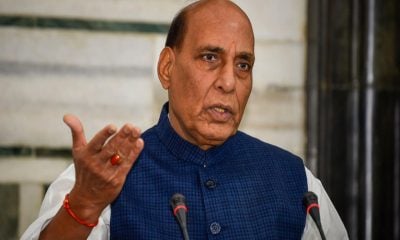While the government builds up a campaign against foreign migrants and refugees here, the irony is it is India that tops the world as country of origin of international migrants, while the number of international migrants within India has been declining.
According to the International Migrant Stock 2019, a dataset released by the Population Division of the UN Department of Economic and Social Affairs (DESA) today – Wednesday, September 18 – India was the leading country of origin of international migrants in 2019 with a 17.5 million strong diaspora.
The number of migrants globally reached an estimated 272 million, 51 million more migrants in the world in 2019 than in 2010, a 23 per cent increase. It said migrants account for 3.5 per cent of the world’s population today, compared with 2.8 per cent in 2000.
Europe and North America have absorbed the largest share of the world’s 272 million migrants: there were 82 million migrants living in Europe and 59 million in North America in 2019, followed by northern Africa and western Asia with 49 million each.
The estimates are based on official national statistics on the foreign-born or the foreign population obtained from population censuses, population registers or nationally representative surveys.
Top 10 countries of origin
The top 10 countries of origin account for one-third of all international migrants. In 2019, with 17.5 million persons living abroad, India was the leading country of origin of international migrants.
The graph from the report also indicates that the outflow from India rose suddenly after 2005.
Top 20 countries of origin of international migrants
Migrants from Mexico constituted the second largest diaspora (11.8 million), followed by China (10.7 million), Russia (10.5 million), Syria (8.2 million), Bangladesh (7.8 million), Pakistan (6.3 million), Ukraine (5.9 million), the Philippines (5.4 million) and Afghanistan (5.1 million).
No. of migrants and refugees in India
India hosted 5.1 million international migrants in 2019, less than the 5.2 million in 2015. International migrants as a share of total population in India was steady at 0.4% from 2010 to 2019.
The country hosted 207,000 refugees, the report said, adding that refugees as a share of international migrants in the country was four per cent. Among the international migrants in the country, the female population was 48.8% and the median age of international migrants was 47.1 years.
The highest number of international migrants in India were from Bangladesh, Pakistan and Nepal.
Regions and countries hosting largest no. of migrants
In 2019, regionally, Europe hosted the largest number of international migrants (82 million), followed by Northern America (59 million) and Northern Africa and Western Asia (49 million).
At the country level, about half of all international migrants reside in just 10 countries, with the United States of America hosting the largest number of international migrants (51 million), equal to about 19% of the world’s total.
Germany and Saudi Arabia host the second and third largest numbers of migrants (13 million each), followed by Russia (12 million), the United Kingdom (10 million), the United Arab Emirates (9 million), France, Canada and Australia (around 8 million each) and Italy (6 million).
Countries hosting largest no. of migrants
Share of migrants in population
The share of international migrants in total population varies considerably across geographic regions with the highest proportions recorded in Oceania (including Australia and New Zealand) (21.2%) and Northern America (16.0%) and the lowest in Latin America and the Caribbean (1.8%), Central and Southern Asia (1.0%) and Eastern and South-Eastern Asia (0.8%).
A majority of international migrants in sub-Saharan Africa (89%), Eastern and South-Eastern Asia (83%), Latin America and the Caribbean (73%), and Central and Southern Asia (63%) originated from the region in which they reside.
By contrast, most of the international migrants that lived in Northern America (98%), Oceania (88%) and Northern Africa and Western Asia (59%) were born outside their region of residence.
Forced displacements
The report added that forced displacements across international borders continues to rise.
Between 2010 and 2017, the global number of refugees and asylum seekers increased by about 13 million, accounting for close to a quarter of the increase in the number of all international migrants.
Northern Africa and Western Asia hosted around 46% of the global number of refugees and asylum seekers, followed by sub-Saharan Africa (21%).
Gender-wise
Turning to the gender composition, women comprise slightly less than half of all international migrants in 2019.
The share of women and girls in the global number of international migrants fell slightly, from 49% in 2000 to 48% in 2019.
The share of migrant women was highest in Northern America (52%) and Europe (51%), and lowest in sub-Saharan Africa (47%) and Northern Africa and Western Asia (36%).
In terms of age, one out of every seven international migrants is below the age of 20 years.
Migration and development
The link between migration and development is “very well established,” Director for DESA’s Population Division, John Wilmoth told reporters at the UN, echoing the message from the Department’s Under-Secretary General ahead of the report release.
The data “are critical”, Llu Zhenmin said, “for understanding the important role of migrants and migration in the development of both countries of origin and destination.”
“Facilitating orderly, safe, regular and responsible migration and mobility of people will contribute much to achieving the Sustainable development Goals,” he urged.
Wilmoth said as a general observation, the contribution of migrants both in host countries and countries of origin, includes sending valuable remittances back to countries of origin, and a major social contribution through transmission of ideas.
The United Nations is committed to supporting safe migration, through international agreements to safeguard refugees and people on the move at large, said a statement from the organisation. The Global Compact on Refugees, and Global Compact for Safe, Orderly and Regular Migration, were adopted in December of last year.


 India News13 hours ago
India News13 hours ago
 India News6 hours ago
India News6 hours ago
 India News11 hours ago
India News11 hours ago
 Cricket news11 hours ago
Cricket news11 hours ago
 India News11 hours ago
India News11 hours ago
 India News6 hours ago
India News6 hours ago
 Latest world news6 hours ago
Latest world news6 hours ago



















